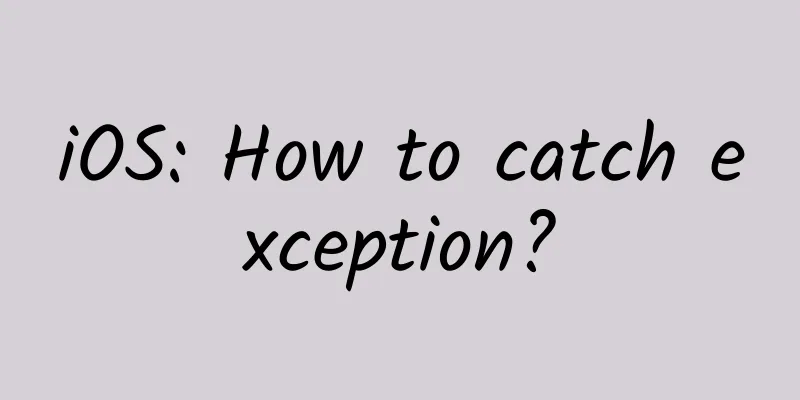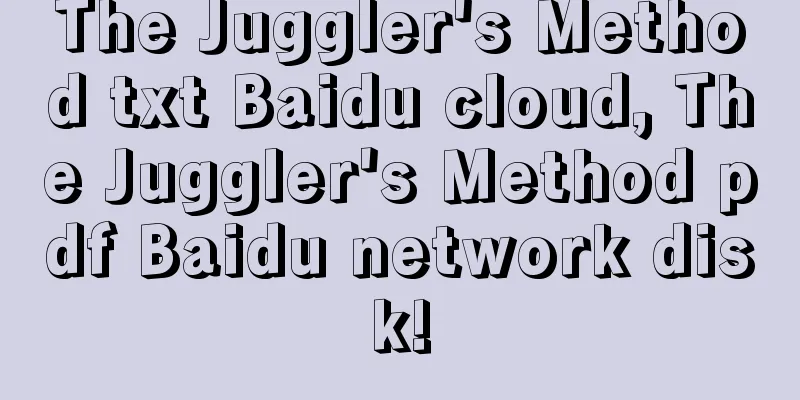iOS: How to catch exception?

|
Table of Contents 1. System Crash 2. Processing signals
3. Actual Combat 4. Crash Callstack Analysis – Further Analysis 5. Demo address VI. References Preface Today in the iOS senior group, a friend asked about the problem of iOS exception capture. I have never studied this before, so I took this opportunity to study it. I also wrote a demo, which can be downloaded at the bottom of the article if needed. Before reading this article, it is recommended that you read the article Talking about iOS Crash Collection Framework after reading this article to understand the principle. When developing iOS applications, solving the Crash problem is always a difficult problem. There are two types of Crash. One is caused by EXC_BAD_ACCESS, which is caused by accessing a memory address that does not belong to the process, which may be accessing released memory; the other is an uncaught Objective-C exception (NSException), which causes the program to send a SIGABRT signal to itself and crash. In fact, for uncaught Objective-C exceptions, we have a way to record it. If the log is recorded properly, most crash problems can be solved. Here are the UI threads and background threads respectively. 1. System Crash The abnormal exit of the program caused by system crash can be caught by the UncaughtExceptionHandler mechanism; that is, the content outside the catch in the program is caught by the system's built-in error handling. All we have to do is replace the ExceptionHandler with a custom function. 2. Processing signals Using Objective-C's exception handling does not get signals. If we want to handle it, we also need to use the Unix standard signal mechanism to register processing functions for signals such as SIGABRT, SIGBUS, and SIGSEGV. In this function, we can output stack information, version information, and everything else we want. Here are some signal descriptions 1) SIGHUP This signal is sent when a user terminal connection ends (normally or abnormally), usually when the controlling process of the terminal ends, to notify the jobs in the same session that they are no longer associated with the controlling terminal. When you log in to Linux, the system will assign a terminal (Session) to the logged-in user. All programs running in this terminal, including the foreground process group and the background process group, generally belong to this Session. When the user logs out of Linux, the foreground process group and the background process with terminal output will receive the SIGHUP signal. The default operation of this signal is to terminate the process, so the foreground process group and the background process with terminal output will be terminated. However, this signal can be captured. For example, wget can capture the SIGHUP signal and ignore it, so that even if you log out of Linux, wget can continue to download. In addition, for a daemon that is disconnected from a terminal, this signal is used to notify it to re-read the configuration file. 2) SIGINT Program termination (interrupt) signal, sent when the user types the INTR character (usually Ctrl-C), is used to notify the foreground process group to terminate the process. 3) SIGQUIT Similar to SIGINT, but controlled by the QUIT character (usually Ctrl-). A process creates a core file when it exits due to SIGQUIT, which is similar to a program error signal in this sense. 4) SIGILL An illegal instruction was executed. This is usually caused by an error in the executable file itself, or an attempt to execute a data segment. This signal may also be generated by a stack overflow. 5) SIGTRAP Generated by a breakpoint instruction or other trap instruction. Used by the debugger. 6) SIGABRT The signal generated by calling the abort function. 7) SIGBUS Illegal address, including memory address alignment errors. For example, accessing a four-word integer, but its address is not a multiple of 4. It is different from SIGSEGV in that the latter is triggered by illegal access to a legal storage address (such as accessing non-own storage space or read-only storage space). 8) SIGFPE Emitted when a fatal arithmetic error occurs. This includes not only floating point errors, but also overflows and division by zero and all other arithmetic errors. 9) SIGKILL Used to terminate the program immediately. This signal cannot be blocked, processed or ignored. If the administrator finds that a process cannot be terminated, he can try to send this signal. 10) SIGUSR1 Leave it to the user 11) SIGSEGV An attempt was made to access memory that was not allocated to the user, or an attempt was made to write data to a memory address that the user did not have permission to write to. 12) SIGUSR2 Leave it to the user 13) SIGPIPE Pipeline Broken. This signal is usually generated in inter-process communication. For example, if two processes communicate using FIFO (pipe) and the reading pipe is not open or terminated unexpectedly, the writing process will receive the SIGPIPE signal. In addition, if two processes communicate using Socket, the reading process has terminated when the writing process writes to the Socket. 14) SIGALRM Clock timing signal, which calculates the actual time or clock time. The alarm function uses this signal. 15) SIGTERM The program terminate signal. Unlike SIGKILL, this signal can be blocked and processed. It is usually used to require the program to exit normally. The shell command kill generates this signal by default. If the process cannot be terminated, we will try SIGKILL. 17) SIGCHLD When the child process ends, the parent process will receive this signal. If the parent process does not handle this signal and does not wait for the child process, the child process will terminate but will still occupy an entry in the kernel process table. This child process is called a zombie process. We should avoid this situation (the parent process should either ignore the SIGCHILD signal, capture it, wait for its derived child process, or terminate the parent process first, in which case the termination of the child process will be automatically taken over by the init process). 18) SIGCONT Allows a stopped process to continue execution. This signal cannot be blocked. A handler can be used to allow the program to complete specific work when it changes from the stopped state to the continued state. For example, redisplay the prompt 19) SIGSTOP The execution of the process is stopped. Note the difference between it and terminate and interrupt: the process is not terminated, but just suspended. This signal cannot be blocked, processed or ignored. 20) SIGTSTP Stops the process from running, but the signal can be handled and ignored. This signal is emitted when the user types the SUSP character (usually Ctrl-Z). 21) SIGTTIN When a background job tries to read data from the user terminal, all processes in the job will receive a SIGTTIN signal. By default, these processes will stop executing. 22) SIGTTOU Similar to SIGTTIN, but received when writing to the terminal (or changing the terminal mode). 23) SIGURG Generated when "urgent" data or out-of-band data arrives at the socket. 24) SIGXCPU CPU time resource limit exceeded. This limit can be read/changed with getrlimit/setrlimit. 25) SIGXFSZ When a process attempts to enlarge a file so that it exceeds the file size resource limit. 26) SIGVTALRM Virtual clock signal. Similar to SIGALRM, but it counts the CPU time used by the process. 27) SIGPROF Similar to SIGALRM/SIGVTALRM, but includes CPU time used by the process as well as time spent in system calls. 28) SIGWINCH Emitted when the window size changes. 29) SIGIO The file descriptor is ready for input/output operations. 30) SIGPWR Power failure 31) SIGSYS Illegal system call. Key points to note
3. Actual Combat 1. AppDelegate.m
2. Implementation of SignalHandler.m
For more information about error types, see the description above. SignalExceptionHandler is the callback for signal errors. When a signal error occurs, you can call back to this method. 3. Implementation of UncaughtExceptionHandler.m
4. Testing – the key to avoiding pitfalls The most critical step here is not to test SignalHandler in debug environment. Because the system debug will intercept first. We need to run it once and then turn off debug status. We should directly click on the app we built on the simulator to run it. UncaughtExceptionHandler can capture it in debug mode.
4. Crash Callstack Analysis – Further Analysis
5. Demo address iOSCrashUncaught Download https://github.com/xcysuccess/iOSCrashUncaught VI. References 1. Debugging skills after program crash 2. The problem of iOS socket program being terminated by SIGPIPE signal 3. Beautiful Nian Xi 4. How to locate random crashes of wild pointers in Obj-C (I): First, increase the wild pointer crash rate 5. How to locate random crashes in Obj-C wild pointers (Part 2): Make non-necessary crashes mandatory 6. How to locate the random crash of Obj-C wild pointer (Part 3): Add some black technology to make the crash reveal itself |
<<: Aite Tribe Story Collection (12): Habits lead to skill improvement
>>: An Android client architecture design sharing
Recommend
2019, the year marketers “swim naked”
Everyone knows that my writing is usually very dr...
How long can a pair of self-heating insoles last?
As we all know, the cold starts from the feet, es...
Apple releases important iOS 14.8 update: All updates are required to fix security vulnerabilities
Apple today released iOS 14.8, the eighth major u...
How can Douyin increase followers quickly and effectively?
There are three ways to increase followers: conte...
How to efficiently guide products to achieve self-propagation growth model
As a member of the growth department, when observ...
How to invest in Baidu bidding and CPC in 2021?
We all know that now o cpc has become the mainstr...
The calm before the outbreak? Comprehensive thinking about "Mini Programs"
Since WeChat announced the upcoming release of Mi...
How to find more than 200 channels in App promotion
Start from seven aspects including website naviga...
New function of Sunflower 6.0 mobile control terminal: mobile phone control computer without logging in to find "nearby people"
The new Sunflower control terminal iOS6.0 and And...
Summary of the ten core advantages of HTML 5
[51CTO.com Quick Translation] What is the most po...
Douyin operation: 4 tips to teach you how to create a Douyin hit from scratch!
Regarding "Tik Tok", many people will r...
How to plan an event with high user participation?
0. What is event operation? Before we talk about ...
What are the characteristics of the facial recognition system at the construction site entrance and exit?
With the development of technology, facial recogn...
Five paths to building a TOB brand
When I was thinking about the issues of TOB brand...
360 Search Brand Direct-Entertainment CPT Advertising Promotion Introduction!
360 Brand Direct-Entertainment...









